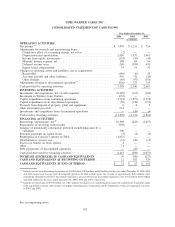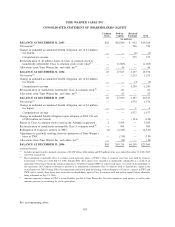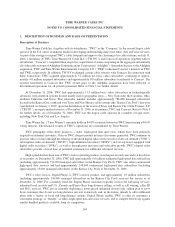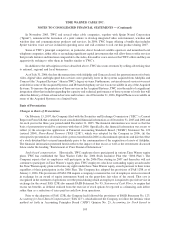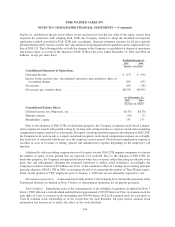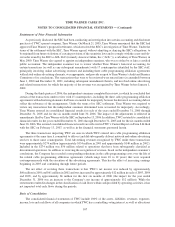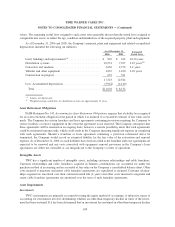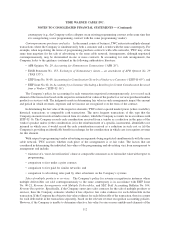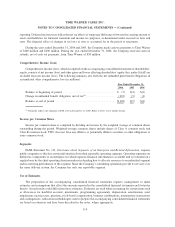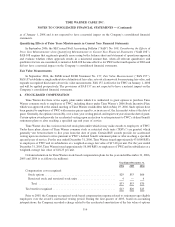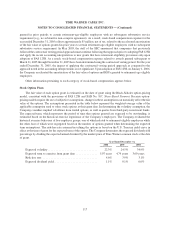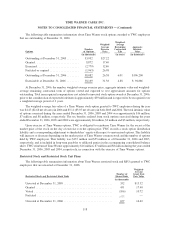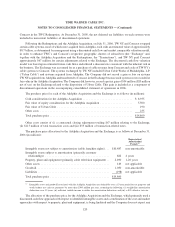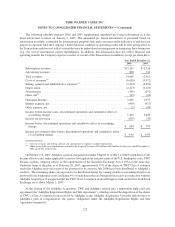Time Warner Cable 2006 Annual Report Download - page 117
Download and view the complete annual report
Please find page 117 of the 2006 Time Warner Cable annual report below. You can navigate through the pages in the report by either clicking on the pages listed below, or by using the keyword search tool below to find specific information within the annual report.counterparty (e.g., the Company settles a dispute on an existing programming contract at the same time that
it is renegotiating a new programming contract with the same programming vendor).
Contemporaneous purchases and sales. In the normal course of business, TWC enters into multiple-element
transactions where the Company is simultaneously both a customer and a vendor with the same counterparty. For
example, when negotiating the terms of programming purchase contracts with cable networks, TWC may at the
same time negotiate for the sale of advertising to the same cable network. Arrangements, although negotiated
contemporaneously, may be documented in one or more contracts. In accounting for such arrangements, the
Company looks to the guidance contained in the following authoritative literature:
• APB Opinion No. 29, Accounting for Nonmonetary Transactions (“APB 29”);
• FASB Statement No. 153, Exchanges of Nonmonetary Assets — an amendment of APB Opinion No. 29
(“FAS 153”);
• EITF Issue No. 01-09, Accounting for Consideration Given by a Vendor to a Customer (“EITF 01-09”); and
• EITF Issue No. 02-16, Accounting by a Customer (Including a Reseller) for Certain Consideration Received
from a Vendor (“EITF 02-16”).
The Company’s policy for accounting for each transaction negotiated contemporaneously is to record each
element of the transaction based on the respective estimated fair values of the products or services purchased and the
products or services sold. The judgments made in determining fair value in such arrangements impact the amount
and period in which revenues, expenses and net income are recognized over the term of the contract.
In determining the fair value of the respective elements, TWC refers to quoted market prices (where available),
historical transactions or comparable cash transactions. The most frequent transactions of this type that the
Company encounters involve funds received from its vendors, which the Company accounts for in accordance with
EITF 02-16. The Company records cash consideration received from a vendor as a reduction in the price of the
vendor’s product unless (i) the consideration is for the reimbursement of a specific, incremental, identifiable cost
incurred in which case it would record the cash consideration received as a reduction in such cost or (ii) the
Company is providing an identifiable benefit in exchange for the consideration in which case it recognizes revenue
for this element.
With respect to programming vendor advertising arrangements being negotiated simultaneously with the same
cable network, TWC assesses whether each piece of the arrangements is at fair value. The factors that are
considered in determining the individual fair values of the programming and advertising vary from arrangement to
arrangement and include:
• existence of a “most-favored-nation” clause or comparable assurances as to fair market value with respect to
programming;
• comparison to fees under a prior contract;
• comparison to fees paid for similar networks; and
• comparison to advertising rates paid by other advertisers on the Company’s systems.
Sales of multiple products or services. The Company’s policy for revenue recognition in instances where
multiple deliverables are sold contemporaneously to the same counterparty is in accordance with EITF Issue
No. 00-21, Revenue Arrangements with Multiple Deliverables, and SEC Staff Accounting Bulletin No. 104,
Revenue Recognition. Specifically, if the Company enters into sales contracts for the sale of multiple products or
services, then the Company evaluates whether it has objective fair value evidence for each deliverable in the
transaction. If the Company has objective fair value evidence for each deliverable of the transaction, then it accounts
for each deliverable in the transaction separately, based on the relevant revenue recognition accounting policies.
However, if the Company is unable to determine objective fair value for one or more undelivered elements of the
112
TIME WARNER CABLE INC.
NOTES TO CONSOLIDATED FINANCIAL STATEMENTS — (Continued)


